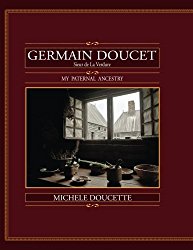Book 17: Germain Doucet (Sieur de LaVerdure): My Paternal Genealogy
Germain Doucet (Sieur de LaVerdure): My Paternal Ancestry
Following the St. Germain-en-Laye Treaty of March 29, 1632, it was by order of Cardinal Richelieu (Minister of State to King Louis XIII), that Commander Isaac de Razilly came to re-occupy the colony; so, too, did Germain Doucet (Sieur de La Verdure), the progenitor of this author’s family, accompany him. Sailing from France on July 4, 1632, they arrived with a variety of livestock, seeds, tools, implements, arms, munitions, and other supplies, at La Have (LaHève), located at the mouth of the La Have River in present day Lunenburg County, Nova Scotia, on September 8.
In keeping with the forced Deportation of the French Acadian people, the family of Joseph Doucet and Anne Surette were exiled from Port Royal, to Massachusetts, on December 4, 1755. After a few weeks in Boston, they were assigned to the town of Gloucester in County Essex. Less than ten years later, Joseph is listed on a petition, to the Governor of Massachusetts, dated August 24, 1763, seeking permission, together with one hundred seventy-nine families, to return to Old France, which was not to be. Several years later, a second attempt was made. On February 8, 1766, one hundred forty-seven families (a total of eight hundred ninety souls), including Joseph Doucet, asked for permission to leave Massachusetts, in order to return to Canada; as before, they were unable to leave.
It was during the following year, 1767, that the Acadians petitioned Governor Franklin of Nova Scotia for land on which to settle. As they were Roman Catholic, they could not be granted land. The Governor, however, allotted them land, along the shore of Baie Sainte-Marie (today known as St. Mary’s Bay) on December 23, 1767. Joseph Doucet spent the first winter at Annapolis Royal (formerly Port Royal, his original home).
With land surveyed in 1768, the township of Clare was laid out along Baie Sainte-Marie. Joseph Doucet settled near what is today called Church Point. The records show that, after completing the necessary requirements, he was granted title to Lot 58 (103 acres), in the township of Clare, on May 18, 1775, living there for the rest of his life, as both fisherman and farmer. Several of his sons, namely Joseph, Charles, Jean Magloire and Michel, settled further south in Yarmouth County, the area of this author’s roots.
522 pages and 2340 footnotes
July 2012
Who was Germain Doucet? Other than Michele Doucette’s great-ancestor (and great-ancestor to many others), this man lived and was an important fixture in the early 1600s in the French settlement of Port Royal, Nova Scotia.
This was the beginning of Acadian history, one that spans generations and centuries and included a massive expulsion to various settlements along the east coast of the United States. It is a fascinating story and what makes it even more fascinating is that Ms Doucette was able to trace her lineage all the way back to the early days of colonial Nova Scotia, a time when birth and death records were sketchy at best.
Germain Doucet (Sieur de La Verdure): My Paternal Ancestry is a thorough research project that studies every possible angle of ancestral connection between the author, Michele Doucette and the seventeenth-century Port Royal resident, Germain Doucet. The author used the very modern and very expensive technique of genetic genealogy to trace her DNA back to Germain. It’s a very complicated process.
As one realizes when studying the pages and pages of who descended from whom, one can’t help but think that they are, in fact, reading the Book of Exodus which reads on and on of who begat whom. It may, at times, be dry reading, but it’s interesting to follow the ancestral links that go back to the days of early settlement in Nova Scotia.
Michele Doucette spent twenty years compiling her research for this book. It’s not surprising that it took her so long. She had four hundred years to research, documents to discover and copy, cemeteries to visit and record, detailed narrative reports to read, and DNA testing to oversee. Genealogy research is intensive research.
With a Masters Degree in Literacy Education, Ms. Doucette has the organizational skills and the academic acumen to put this research project together in a readable/useable resource. Anyone working on their own family genealogy would definitely find this book useful, not only in suggesting some possible links to pursue, but also as it presents a concise format in which one can lay out one’s family tree.
Germain Doucet (Sieur de La Verdure): My Paternal Ancestry as a reference book, is a must study for genealogy enthusiasts.
It is recommended as an excellent resource for those working on their family genealogy.
Award Winning Author Emily Jane Hills Orford, Allbooks Review International



